| Columns Retired Columns & Blogs |
Spectrum Audio 108cd loudspeaker Measurements
Sidebar 2: Measurements
The Spectrum's plot of impedance magnitude and phase (fig.1) indicates that it is a very easy load for an amplifier to drive, only dropping below 8 ohms in the midrange and then only by a small fraction of an ohm. The 108cd is also sensitive, 2.83V raising 88.5dB (B-weighted) at 1m.
The tuning of the 3"-diameter port is revealed by the impedance saddle at 55Hz. Note, however, the wrinkles in the traces at 180Hz and 220Hz, indicating the presence of resonances of some kind. And listening to the 108cd's panels with a stethoscope while sweeping a sinewave up and down, I could hear and feel strong vibrations at 180Hz from all the enclosure's panels, while the 220Hz resonance was most strong on the top panel. Though there was no impedance wrinkle at this frequency, the back panel also vibrated strongly at 410Hz. Abruptly stopping the swept sinewave left a hooty overhang audible as the resonances decayed. While it is unrealistic to expect a manufacturer to be able to provide a totally well-damped, rigid enclosure for a loudspeaker at the 108cd's price point, it is probable that the speaker's lively cabinet did contribute to the sense of sonic confusion detected by LB in his auditioning.

Fig.1 Spectrum 108cd, electrical impedance (solid) and phase (dashed) (2 ohms/vertical div.).
Fig.2 shows the 108cd's overall response on the tweeter axis, averaged across a 30° horizontal window and spliced to the nearfield responses of the port and woofer. The top trace in the bass is the complex sum of the woofer and port outputs, weighted in the ratio of their diameters. Peaking slightly in the upper bass, it rolls off below 100Hz, reaching a –6dB point at the port tuning frequency. The reflex alignment seems well-arranged, though, as LB, found, the little Spectrum's low frequencies benefit from some boundary reinforcement. Note the slight notch in the nearfield responses at 180Hz, the frequency of the strong cabinet vibrational mode.

Fig.2 Spectrum 108cd, anechoic response on tweeter axis at 50", averaged across 30° horizontal window and corrected for microphone response, with nearfield woofer and port responses plotted below 300Hz and 2.5kHz, respectively, and complex sum of nearfield woofer and port responses (top trace below 300Hz).
On the right of fig.2, a gentle downward slope from the midrange upward is broken by large peaks at 3kHz and 5.8kHz. These could be heard as a distinct whistle superimposed on the pseudo-random MLSSA noise; these, I am sure, led to LB's dissatisfaction with the 108cd's treble performance rather than the slight energy excess in the very top octave. The 108cd's waterfall plot (fig.3) indicates that the 3kHz peak is associated with a resonance, perhaps from a woofer-cone breakup mode.

Fig.3 Spectrum 108cd, cumulative spectral-decay plot at 50" (0.15ms risetime).
The 108cd's plots of lateral and vertical dispersion (figs.4 and 5, respectively) are generally similar, due to the coaxial tweeter arrangement. In both cases, the speaker maintains its response to 30° or so off-axis. (Ignore the peakiness above 20kHz in these plots, which is due to an on-axis notch filling in off-axis.)

Fig.4 Spectrum 108cd, horizontal response family at 50", normalized to response on tweeter axis, from back to front: differences in response 90°–5° off-axis; reference response; differences in response 5°–90° off-axis.

Fig.5 Spectrum 108cd, vertical response family at 50", normalized to response on tweeter axis, from back to front: differences in response 45°–5° above tweeter axis; reference response; differences in response 5°–45° below tweeter axis.
Finally, the step response (fig.6) shows that using a tweeter mounted in front of the woofer gives a non-coherent time-domain performance. The tweeter's output is the negative-going spike of energy just after the 3.5ms mark; the woofer's output is the broader, positive-going pulse at the 4ms mark, its decay broken by ringing at the 3kHz frequency.—John Atkinson

Fig.6 Spectrum 108cd, step response on tweeter axis at 50" (5ms time window, 30kHz bandwidth).
- Log in or register to post comments




































